Unit1 Grammar
- 格式:doc
- 大小:63.00 KB
- 文档页数:4
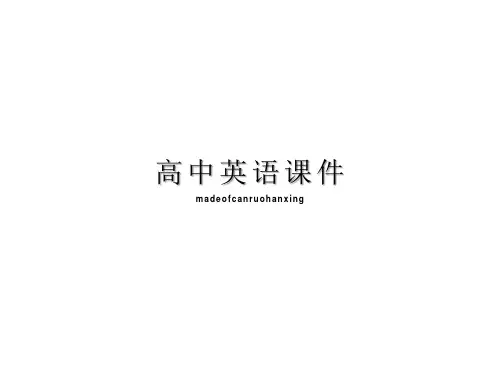
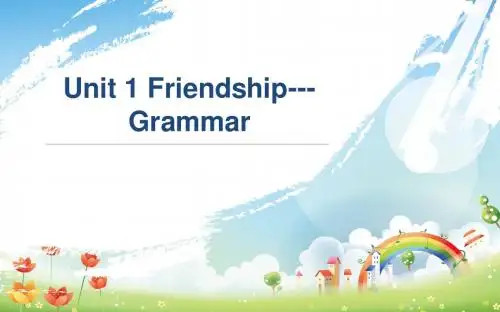
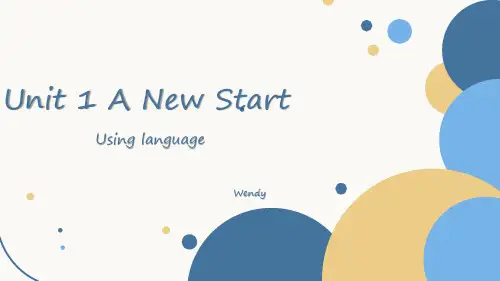
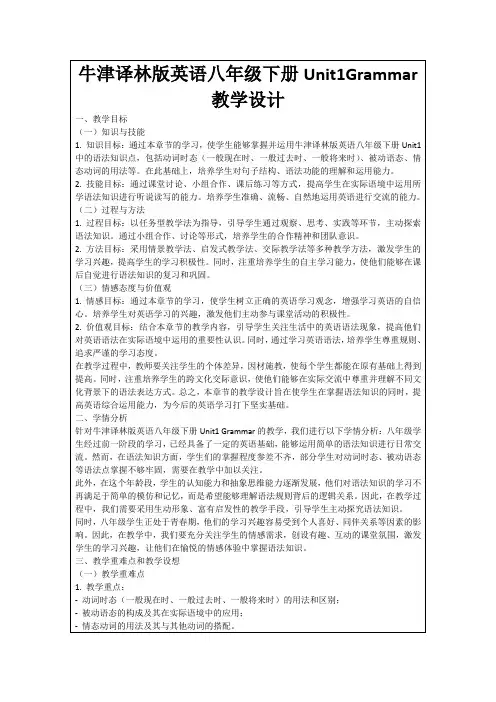
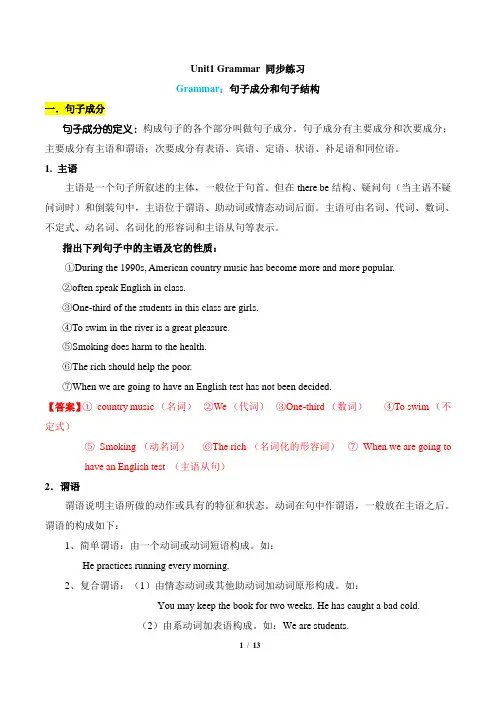
Unit1 Grammar 同步练习Grammar:句子成分和句子结构一.句子成分句子成分的定义:构成句子的各个部分叫做句子成分。
句子成分有主要成分和次要成分;主要成分有主语和谓语;次要成分有表语、宾语、定语、状语、补足语和同位语。
1. 主语主语是一个句子所叙述的主体,一般位于句首。
但在there be结构、疑问句(当主语不疑问词时)和倒装句中,主语位于谓语、助动词或情态动词后面。
主语可由名词、代词、数词、不定式、动名词、名词化的形容词和主语从句等表示。
指出下列句子中的主语及它的性质:①During the 1990s, American country music has become more and more popular.②often speak English in class.③One-third of the students in this class are girls.④To swim in the river is a great pleasure.⑤Smoking does harm to the health.⑥The rich should help the poor.⑦When we are going to have an English test has not been decided.【答案】①country music (名词)②We (代词)③One-third (数词)④To swim (不定式)⑤Smoking (动名词)⑥The rich (名词化的形容词)⑦When we are going tohave an English test (主语从句)2.谓语谓语说明主语所做的动作或具有的特征和状态。
动词在句中作谓语,一般放在主语之后。
谓语的构成如下:1、简单谓语:由一个动词或动词短语构成。
如:He practices running every morning.2、复合谓语:(1)由情态动词或其他助动词加动词原形构成。
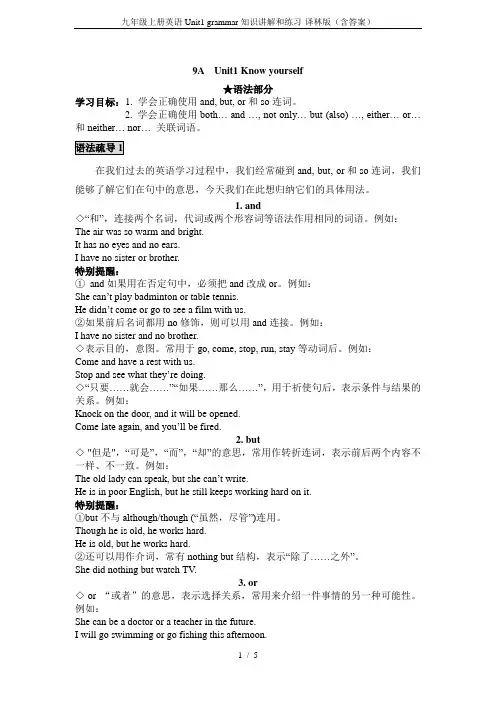
9A Unit1 Know yourself★语法部分学习目标:1. 学会正确使用and, but, or和so连词。
2. 学会正确使用both… and …, not only… but (also) …, either… or…和neither… nor… 关联词语。
在我们过去的英语学习过程中,我们经常碰到and, but, or和so连词,我们能够了解它们在句中的意思,今天我们在此想归纳它们的具体用法。
1. and◇“和”,连接两个名词,代词或两个形容词等语法作用相同的词语。
例如:The air was so warm and bright.It has no eyes and no ears.I have no sister or brother.特别提醒:①and如果用在否定句中,必须把and改成or。
例如:She can’t play badminton or table tennis.He didn’t come or go to see a film with us.②如果前后名词都用no修饰,则可以用and连接。
例如:I have no sister and no brother.◇表示目的,意图。
常用于go, come, stop, run, stay等动词后。
例如:Come and have a rest with us.Stop and see what they’re doing.◇“只要……就会……”“如果……那么……”,用于祈使句后,表示条件与结果的关系。
例如:Knock on the door, and it will be opened.Come l ate again, and you’ll be fired.2. but◇ "但是",“可是”,“而”,“却”的意思,常用作转折连词,表示前后两个内容不一样、不一致。
例如:The old lady can speak, but she can’t write.He is in poor English, but he still keeps working hard on it.特别提醒:①but不与although/though (“虽然,尽管”)连用。
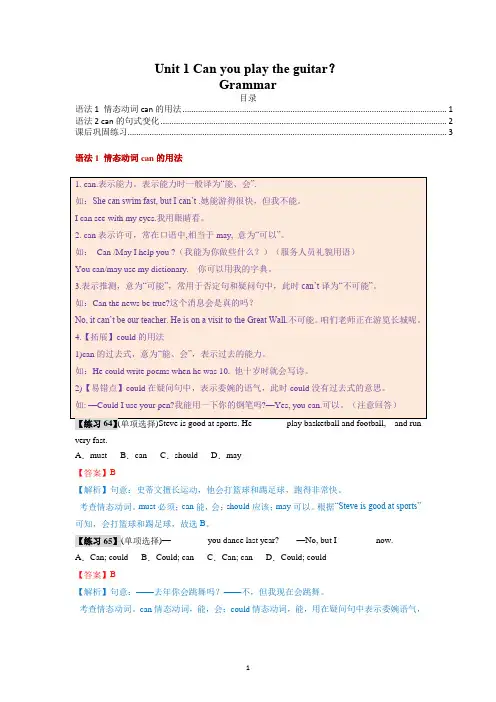
Unit 1 Can you play the guitar?Grammar目录语法1 情态动词can的用法 (1)语法2 can的句式变化 (2)课后巩固练习 (3)语法1 情态动词can的用法very fast.A.must B.can C.should D.may【答案】B【解析】句意:史蒂文擅长运动,他会打篮球和踢足球,跑得非常快。
考查情态动词。
must必须;can能,会;should应该;may可以。
根据“Steve is good at sports”可知,会打篮球和踢足球,故选B。
【练习65】(单项选择)—________ you dance last year? —No, but I ________ now.A.Can; could B.Could; can C.Can; can D.Could; could【答案】B【解析】句意:——去年你会跳舞吗?——不,但我现在会跳舞。
考查情态动词。
can情态动词,能,会;could情态动词,能,用在疑问句中表示委婉语气,也可表示过去的能力,第一空表示过去的能力用could,第二空是肯定句,有时间状语now 用can,故选B。
【练习66】(单项选择)Tom can’t play basketball on school days, but he ________ play it on weekends.A.must B.can C.have to D.should【答案】B【解析】句意:汤姆不能在上学的日子打篮球,但他可以在周末打。
考查情态动词。
must必须、一定;can可以、能够;have to不得不;should应该。
由转折词but可知,前后句之间表达的应是转折关系,前面说不能在上学的日子打篮球,则后面应该是说可以在周末打,因此can符合题意,故选B。
语法2 can的句式变化Bill ________ ________ the piano well.【答案】can play【解析】句意:比尔钢琴弹得很好。
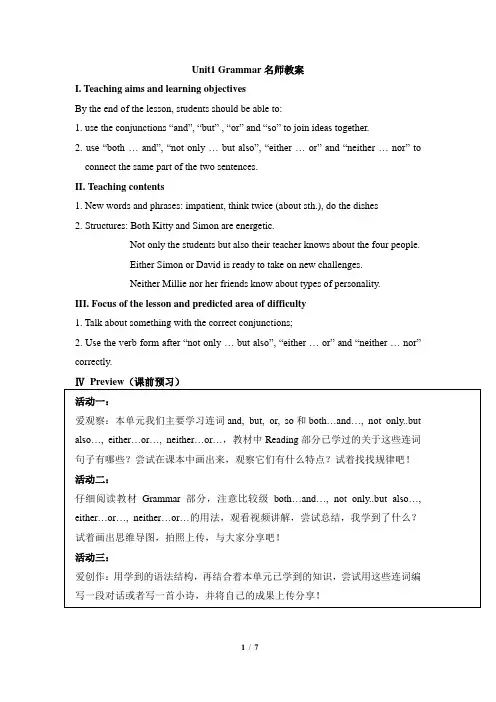
Unit1 Grammar名师教案I. Teaching aims and learning objectivesBy the end of the lesson, students should be able to:1. use the conjunctions “and”, “but” , “or” and “so” to join ideas together.2. use “both… and”, “not only… but also”, “either… or” and “n either … nor” to connect the same part of the two sentences.II. Teaching contents1. New words and phrases: impatient, think twice (about sth.), do the dishes2. Structures: Both Kitty and Simon are energetic.Not only the students but also their teacher knows about the four people.Either Simon or David is ready to take on new challenges.Neither Millie nor her friends know about types of personality.III. Focus of the lesson and predicted area of difficulty1. Talk about something with the correct conjunctions;2. Use the verb form after “not only… but also”, “either… or” and “neither… nor” correctly.ⅣPreview(课前预习)活动一:爱观察:本单元我们主要学习连词and, but, or, so和both…and…, not only..but also…, either…or…, neither…or…,教材中Reading部分已学过的关于这些连词句子有哪些?尝试在课本中画出来,观察它们有什么特点?试着找找规律吧!活动二:仔细阅读教材Grammar部分,注意比较级both…and…, not only..but also…, either…or…, neither…or…的用法,观看视频讲解,尝试总结,我学到了什么?试着画出思维导图,拍照上传,与大家分享吧!活动三:爱创作:用学到的语法结构,再结合着本单元已学到的知识,尝试用这些连词编写一段对话或者写一首小诗,并将自己的成果上传分享!【备注:学生登录“优教·同步学习网”完成本课时预习任务,教师可通过备课端查看预习结果反馈,针对性进行课堂教学】Ⅴ.Teaching proceduresA Using and, but, or and soStep 1 Lead inFree talkT: Today, we’ll learn Grammar of Unit 1.We’ve met four outstanding persons. Do you remember them? (Show the pictures of the characters we’ve learned)S: They are Wu Wei, Su Ning, Liu Tao and Fang Yuan.T: Among them, I admire Wu Wei best because I wanted to be an artist when I was young.【设计意图:通过复习Reading中人物,导入新课,利用已有知识过渡至新板块的学习,使学生迅速进入学习状态。
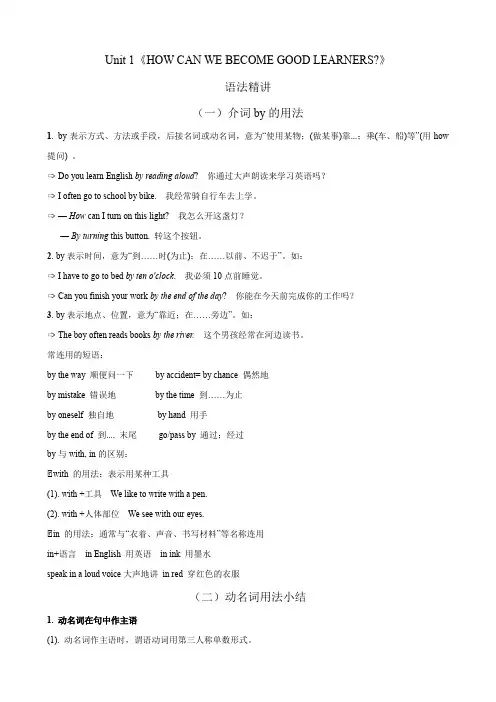
Unit 1《HOW CAN WE BECOME GOOD LEARNERS?》语法精讲(一)介词by的用法1. by表示方式、方法或手段,后接名词或动名词,意为“使用某物;(做某事)靠...;乘(车、船)等”(用how 提问) 。
➩ Do you learn English by reading aloud?你通过大声朗读来学习英语吗?➩ I often go to school by bike. 我经常骑自行车去上学。
➩ — How can I turn on this light? 我怎么开这盏灯?— By turning this button. 转这个按钮。
2. by表示时间,意为“到……时(为止);在……以前、不迟于”。
如:➩ I have to go to bed by ten o'clock. 我必须10点前睡觉。
➩ Can you finish your work by the end of the day? 你能在今天前完成你的工作吗?3. by表示地点、位置,意为“靠近;在……旁边”。
如:➩ The boy often reads books by the river. 这个男孩经常在河边读书。
常连用的短语:by the way 顺便问一下by accident= by chance 偶然地by mistake 错误地by the time 到……为止by oneself 独自地by hand 用手by the end of 到.... 末尾go/pass by 通过;经过by与with, in的区别:◆with 的用法:表示用某种工具(1). with +工具We like to write with a pen.(2). with +人体部位We see with our eyes.◆in 的用法:通常与“衣着、声音、书写材料”等名称连用in+语言in English 用英语in ink 用墨水speak in a loud voice大声地讲in red 穿红色的衣服(二)动名词用法小结1. 动名词在句中作主语(1). 动名词作主语时,谓语动词用第三人称单数形式。
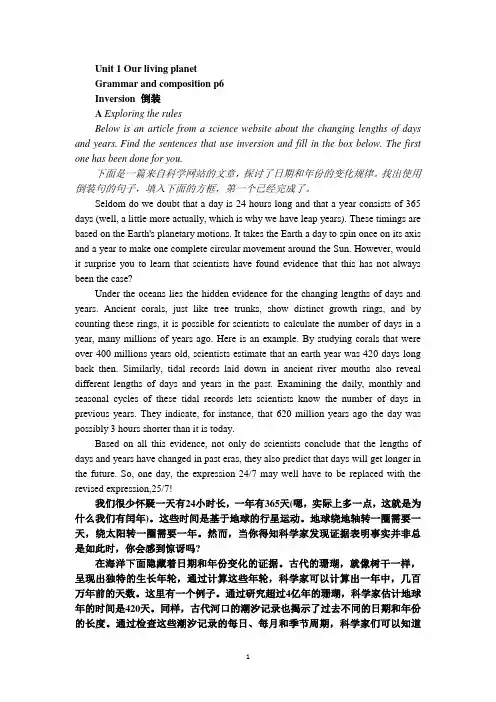
Unit 1 Our living planetGrammar and composition p6Inversion 倒装A Exploring the rulesBelow is an article from a science website about the changing lengths of days and years.Find the sentences that use inversion and fill in the box below. The first one has been done for you.下面是一篇来自科学网站的文章,探讨了日期和年份的变化规律。
找出使用倒装句的句子,填入下面的方框,第一个已经完成了。
Seldom do we doubt that a day is 24 hours long and that a year consists of 365 days (well, a little more actually, which is why we have leap years). These timings are based on the Earth's planetary motions. It takes the Earth a day to spin once on its axis and a year to make one complete circular movement around the Sun. However, would it surprise you to learn that scientists have found evidence that this has not always been the case?Under the oceans lies the hidden evidence for the changing lengths of days and years. Ancient corals, just like tree trunks, show distinct growth rings, and by counting these rings, it is possible for scientists to calculate the number of days in a year, many millions of years ago. Here is an example. By studying corals that were over 400 millions years old, scientists estimate that an earth year was 420 days long back then. Similarly, tidal records laid down in ancient river mouths also reveal different lengths of days and years in the past. Examining the daily, monthly and seasonal cycles of these tidal records lets scientists know the number of days in previous years. They indicate, for instance, that 620 million years ago the day was possibly 3 hours shorter than it is today.Based on all this evidence, not only do scientists conclude that the lengths of days and years have changed in past eras, they also predict that days will get longer in the future. So, one day, the expression 24/7 may well have to be replaced with the revised expression,25/7!我们很少怀疑一天有24小时长,一年有365天(嗯,实际上多一点,这就是为什么我们有闰年)。

《高中英语(上外版)》必修第三册Unit 1 Road to Success课时:第3课时课题:Grammar in Use课型:语法课教学设计与说明一.学情分析本节课授课对象为高一第二学期的学生。
经过第一学期的学习,同学们已经有了分词在句子中各项功能的总体概念。
但是大部分同学们对分词各项句法功能的总体框架结构是不清晰的,对分词的各项句法功能各自的特点、重点、难点没有概念。
所以需要帮助学生分项理清特点、重点、难点,并在语言实际交际运用中加以操练并巩固。
二.教材分析单元语法运用Grammar in Use聚焦于分词作补语(宾语补足语和主语补足语)的复习和巩固。
教材P9-10上有三道语法练习题。
第一题旨在分析分词在句子中的功能,认识分词做补语的结构。
第二题旨在辨认分词作补语的结构并能正确区分这一结构中现在分词和过去分词在做补语时的区别。
第三题考查语言的综合运用能力,要求学生在语篇中、在上下文语境中理解、分析、归纳并灵活运用分词作补语这一语法功能,同时要求学生区分分词作补语与分词其它功能的区别。
三.教学设计思路本课为本单元语法教学的第二课时:语法练习课,旨在帮助学生在第一节语法课的基础上复习巩固分词作补语这一语法功能,并为学生创设产出的机会,提高语用能力。
导入部分利用课本P8-9练习I&II,采用归纳演绎教学法复习第一课时学习过的内容,引导学生学会对学过的语法规则进行分类归纳,在头脑中形成非谓语知识体系的网络架构。
操练部分采用任务型教学方法,在遵循学生认知规律的基础上设置多层次能力要求逐步递进的实践任务,引导学生在完成各个层次的任务中逐步实现分词做补语这一语法功能的内化,并在任务中实现learning by using, learning for using的语法学习目标。
Lesson Plan(the 3 period)rdLearning Objectives:By the end of the period, the students are expected to:1. have the ability of classifying and summarizing grammar rules of -ing / -ed forms as complements;2. form the network of -ing / -ed forms as complements in mind so as to distinguish them from other functions of -ing / -ed forms;3. skillfully apply -ing / -ed forms as complements in listening, reading and writing.Learning Procedures:Step I. Revision (Interactive activity)*T: Help the students recall and classify what they learned in the first period of Grammar in Use with the help of Exercise I & II on P 8-9.*Ss: Recall the grammatical rules of -ing / -ed forms used as complements by category.I. -ing form used as complements:feel / hear / listen to / see / watch / look at / notice / observe ... + O. + doing (O. C.)S.+ be felt / heard ... + doing (S. C.)discover / find / smell / catch ... + O. doing (O. C.)S. + be + discovered ... + doing (S. C.)get / have / keep / leave / send / set / start ... + O. doing (O. C.)with + O. + doing (O. C.)II. -ed form used as complements:see / hear / watch / find / feel / consider ...+ O. + done (O. C.)S.+ be seen ... + done (S. C.)get / have / keep / leave / make ... + O. + done (O. C.)declare / like / need / order / want / wish ... + O. + done (O. C.)with + O. + done (O. C.)Note: After working non-stop for twenty hours, he went to bed tired and hungry. (O. C.) The athlete went away quite satisfied with the result of the match. (O.C.)Step II. PracticeI. Identify - ing /- ed forms as complements in the lyrics (Task 1)*T: Play the song “Those Sweet Words” and ask students to identify - ing /- ed forms as complements in the lyrics while enjoying the melody. And then focus on the functions of -ing / -ed forms in “Iknow I saw you saying it.” and “I just h ave to hear t hose sweet words s poken like a melody.” and the meanings of the two sentences.*Ss: Identify - ing /- ed forms as complements and translate the two sentences into Chinese.Those Sweet WordsBy Norah JonesWhat did you sayI know I saw you saying itMy ears won't stop ringingLong enough to hearThose sweet wordsWhat did you sayAnd now the dayThe hour hand has spunBefore the night is doneI just have to hearThose sweet wordsSpoken like a melodyAll your love...II. Apply -ing / -ed forms as complements in individual sentences. (Task 2)*T: Ask students to identify the structure of -ing / -ed forms as complements in the following sentences and then fill in the blanks with proper forms of the verbs given in the box. Call students’attention to the differences between -ing forms as complements and -ed forms as complements.*S: Read the sentences silently and underline the structure of -ing / -ed forms as complements in each sentence and then fill in the blanks with -ing forms or -ed forms based on grammar rules of the differences between -ing forms as complements and -ed forms as complements.III. Apply -ing / -ed forms as complements in a passage. (Task 3)*T: Ask students to read a short passage and fill in the blanks with the -ing / -ed forms of the verbs given in the box. Then circle the ones that are used as complements. Call students’ attention to the differences between -ing / -ed forms as complements and -ing / -ed forms for other functions.*S: Read the short passage silently and circle the structures of -ing / -ed forms as complements in the passage and then fill in the blanks with -ing forms or -ed forms based on grammar rules of the differences between -ing / -ed forms as complements and -ing / -ed forms for other functions.IV. Apply -ing / -ed forms as complements in writing sentences. (Task 4)*T: Ask students to read each sentence in Chinese carefully and make out which category of -ing / -ed forms as complements fits the contexts best based on the given word in the brackets. And then translate the whole sentence into English.*S: First, make out and write down the proper structure of -ing / -ed forms as complements. Then, translate the whole sentence into English.。
高中英语人教版选择性必修第二册unit 1 Grammar表语从句(ThePredicative Clause)一、表语从句的定义:表语从句就是用一个句子作为表语,放在连系动词之后,充当复合句中的表语,用来说明主语是什么或者怎么样。
The problem is puzzling.主语连系动词形容词作表语The problem is when we can get a pay rise. 主语连系动词一个句子作表语一表语从句二、表语从句的构成:系动词+引导词+简单句What I want to say is that I am tired.三、表语从句的用法.可按表语从句的连系动词有:1).最常用连系动词:be(am; is/was; are/were)o一般在句子中译成:“ 日”7E ...China is no longer what she used to be.2).表变化的系动词:get; turn; go; fall; become; grow; come; run。
用法注意:在英语中,系动词一般只有一般现在时和一般过去时两种时态变化形式,没有其他时态变化形式。
但表变化的这类系动词除外,它们有各种时态变化。
It is becoming colder and colder. The food has gone bad.此处还需注意的是become和turn后接表职业的名词时冠词的有无:Two years later, he became a teacher.但Two years later, he turned teacher.另外,g。
表变化时一般指事情向消极、不好的方面转化。
3).所谓“感官动词”:look; sound; ta ste; smell; fbeL般它们在句子中译成:“・・・起来; ...上去”。
此类系动词为高考高频词。
The food tasted good.食物尝起来很香。
长兴职教中心英语专业《英语第三册》导学案编制人:审核人:日期:编号:课题Unit1 HobbiesGrammar班级:学生姓名:组别:【学习目标】1.理解认识状语从句2.可以区分出各种类型的状语从句3.使学生懂得状语从句的定义,句法功能,分类,引导词,及各类状语从句的用法【学习重点】掌握状语从句的概念及分类和状语从句的句法功能。
【学习难点】使学生懂得状语从句的定义,句法功能,分类,引导词,及各类状语从句的用法,【基础部分】一.预习P24-27内容,标出重难点、疑点,完成下列预习自测。
二、预习自测1. 状语从句又称副词性从句,在句中作状语,修饰主句中的动词、形容词或副词等。
状语从句放在主句之前时,常用逗号分开;放在主句之后时,一般不用逗号。
状语从句可分为时间、条件、原因、让步、目的、结果、方式、比较、地点等状语从句。
根据以上定义对状语从句进行分类。
(1)Street dancing is also a kind of strength dancing, because sometimes it needs upside down with only one hand. because引导从句表_____(2) When you practice yoga, you should focus on your thought, your breath and your movement.When 引导从句表示_______(3) What should we do if he comes too late? If 引导从句表_______(4) He got up early so that he might catch the school bus. So that引导从句表_______(5) We will try our best even though we may fail. Even though引导从句表______(6) They looked at me as if I were mad. as if引导从句表____(7) We will go where we are most needed by the country. Where引导从句表______(8) He didn’t take this raincoat so that he got wet all over. So that 引导从句表_____(9) I hope she will make as much progress as you have done. As…as 引导从句表_____2.填空圈出下列状语从句中的连词,并写出状语从句的种类(1)She often takes an MP3 with her wherever she goes. 地点状语从句(2)My uncle taught me several songs when I was a small child____________(3)Since yoga can help people relax and keep fit, many office ladies are fond of it.________(4) If you ask him, he will help you_______(5) Though yoga doesn’t require you to jump or to run, it could hurt you sometimes________(6) His plan was such a good one that we all agreed to accept it.________(7) Say it louder so that everyone can hear you.________(8) He does not work as hard as his brother._________(9)While I was wondering at this, our schoolmaster took his place.________(10) Where there is a will, there is a way. ________(11) Now that/Since everybody is here, let’s begin our meeting.________(12) I’ll speak slowly so that you can understand me. _________(13) So clever was he a student that he was able to work out all the difficult problems. _________(14) As long as you don’t lose heart, you’ll succeed. _______(15) Try as he might, he could not find a job. ____________(16) The old lady treats the boy as if he were his own son. _________【要点部分】按要求完成句子(一)时间状语从句1._____________ we were talking, Mr Smiths came in.2._____ they came home, I was cooking dinner.3.I was about to go to bed _____ I heard someone knock at t the door.(并列句)4. _____ we were watching TV, he was studying.5.He is fat _____ his brother is thin. (并列句)6._____he talked on, he got more and more excited.7._____you grow older ,you will know better and better about yourself.8.They talked ______they walked along the river(二)地点状语从句地点状语从句用连接副词where或wherever (在任何地方) 引导。
1.Just stay _______ you are.2._______ there is a will, there is a way.3._______ there is smoke, there is fire. 无风不起浪。
4.You can sit _______ you like.5._________ you go, I’ll be right here waiting for you.(三)原因状语从句引导这种从句常用的连接词是:because, since, now that, for, as和considering that, seeing that 这七个连词都用于表示表示原因, 但在语气上一个比一个弱。
1.because—直接原因,非推断,语气最强。
回答why的问题,主句前不再使用so。
另外,because前还可以加only, just, completely等修饰性的副词。
2.since/now that –通常放句首。
译为“既然”3.as 不谈自明的原因,译为“由于”,语气最弱。
4.for 放句中,引导后半句表原因, 或补充推断的理由。
练习:1.--Why are you crying, Meg? --- _______ I’ve broken your necklace, mom.2. I went to bed early _______ I was tired.3. I was not kind to him _______ he was poor.4. I was not kind to him, _______ he was rude.5. _____I had a cold, I was absent from school.6. My mother was ill and I sent for Tom, ___ he was a doctor.(四)目的状语从句当从句与主句的主语一致时,可用so as to do …或in order to do …替换so…that…从句He ran fast so that he might arrive there before ten o’clock.He ran fast ___________ arrive there before ten o’clock.(五)结果状语从句结果状语从句句型:“如此……以致……”1.such + a/an+形容词+单数名词+that clause2.such + 形容词+可数名词复数/不可数名词+that...3.so + 形容词+a/an+单数名词+that clause4.so + 形容词/副词+that clause5.so + many/much/few/little+名词+that...注意:so与such引导的结果状语从句之间可互换。
She told us ______ an interesting story that we all forgot about the time.She told us _____ interesting a story that we all forgot about the time.(六)条件状语从句1. We will be able to get there on time, ____ our car doesn’t break down on the road.A. as soon asB. as far asC. as long asD. as well as2. In time of serious accidents, _____ we know some basic things about first aid, we can save lives.A. whetherB. untilC. ifD. unless3. ____ you have tried it, you can’t imagine how pleasant it is.A. UnlessB. BecauseC. AlthoughD. When(七)让步状语从句1.Although多用于句首,不用于中间.2.Though可用于句首,句中; 还可用作副词,用于句末,译为:可是;但是.如: It’s hard work, I enjoy it though.3.Though引导的状语从句还可以把表语提到最前面,而although则不能这样用.(八)比较状语从句比较状语从句常由下列词语引导:as …as, not s o / as … as, more…than, less … than,the 比较级+ adj. / adv., the 比较级+ adj. / adv.练习:1.His brother is ____ handsome ____ he (is).2.The movie was not ______ good ____ I had expected.3.Your bag is twice as expensive as _______ (me).4.The driver drives faster _____ he used to (drive).5.The more knowledge we learn, _________ (happy) we will be.(九)方式状语从句描述主句动作进行方式的状语被称为方式状语。